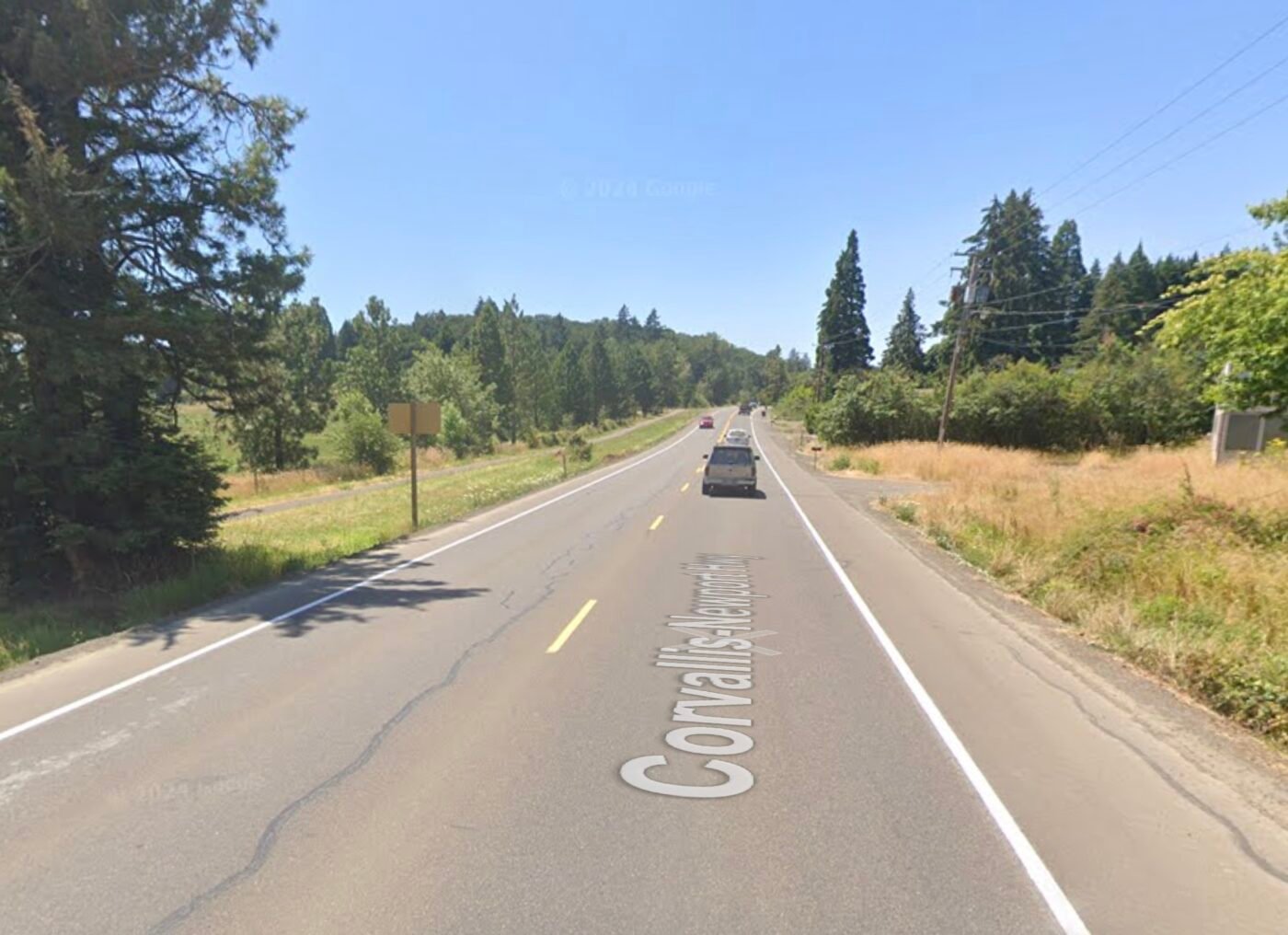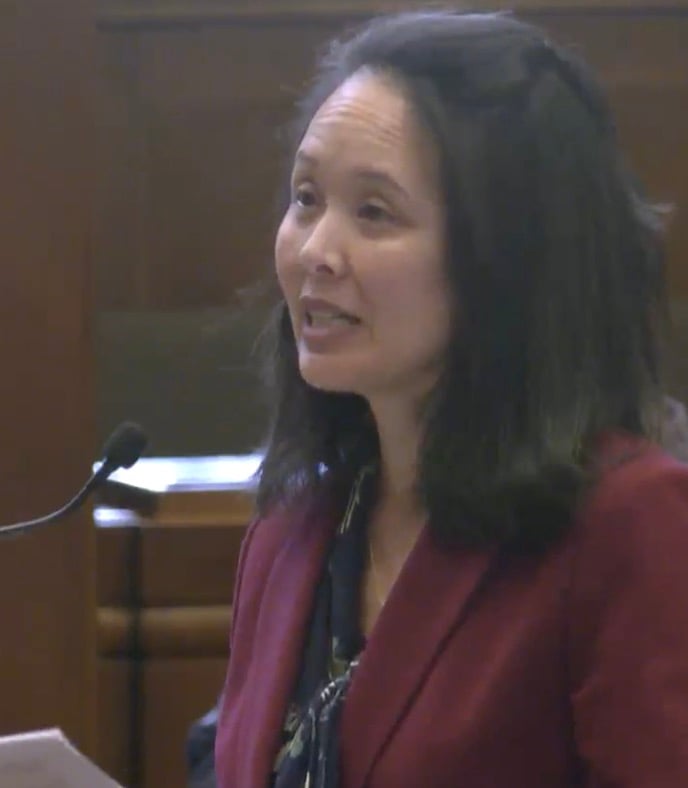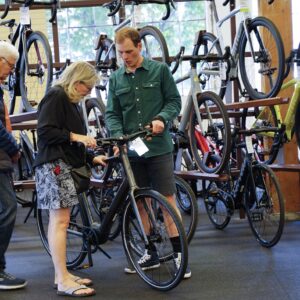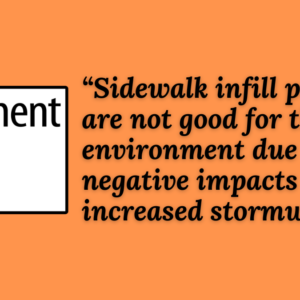Oregon Senator Khanh Pham has planted a flag this legislative session on the idea that repairing and maintaining existing highways is more important than expanding them or building new ones.
On Monday, Senator Pham, a Democrat who represents outer southeast and northeast Portland, was the sole “no” vote on a bill that originally sought to give the Oregon Department of Transportation a blank check to widen a highway. And earlier that morning Pham gave a speech on the Senate floor about the need for more street safety funding.
Senate Bill 564 was proposed by Senator Dick Anderson, a Republican who represents a coastal district between Salem and Eugene. The bill called on ODOT to, “widen and increase the capacity of motor vehicle travel” on a three mile stretch of Highway 20 between Corvallis and Philomath. The bill called for funding through the General Fund, but left the specific amount blank.
In a public hearing for the bill on February 11th, Sen. Anderson, the Mayor of Philomath, and a local county commissioner, all spoke in support. They said folks who live in Philomath have complained to them about bumper-to-bumper traffic when they try to drive to jobs and events in Corvallis (home to Oregon State University). They talked about how “easing congestion” would improve safety and allow more growth and economic development.
Philomath Mayor Christopher McMorran said, “We are not trying to cause any environmental damage. We are trying to find all solutions we can to get folks to work, to get folks to school, to make sure that highway is working for residents.”
The bill was ultimately amended to remove the project appropriation and make it just a “study bill.” Legislative staff estimates the study, which would give lawmakers, “recommendations for increasing the capacity of motor vehicle travel,” would cost about $300,000.
The Joint Committee on Transportation voted on the bill Monday evening. It passed 10-1, with Sen. Pham the only person voting against it.
“I am worried about advancing legislation that’s calling out specific highway widening projects for study,” Pham said in comments before casting her vote, “As opposed to taking a total systems approach looking at our entire transportation system… I just worry about the precedent it sets as we’re gearing up for the 2025 package, especially with so many of the projects with cost overruns that we’re navigating, I think we really need to be focusing on maintaining our existing system.”
Those comments lined up with a speech Pham gave on the Senate Floor that same morning. “Community members are angry, and they have a right to be. This was preventable,” Pham shared as she recounted the death of Roger Lee, who was killed by a driver as he walked across SE Powell Blvd on March 9th. “Many legacy highways currently owned by the Oregon Department of Transportation were designed for cars, but are, of course, used by all modes and are more deadly for all road users, particularly people walking and biking.” “Our state highways are old and outdated and unsafe and suffering from disinvestment,” she continued. “As we discuss how best to use our limited state transportation funds, we need to prioritize investments that make our current system safer, like fully funding our Great Streets program, Safe Routes to School and supporting jurisdictional transfer of some of these roads — whether it’s a logging truck on Highway 30 near Clatskanie, or middle-schooler trying to bike to school across SE Powell Blvd, we must make Oregon streets safer for everyone.”
Pham is also gaining support from across the aisle. Senator Suzanne Weber, a Republican who represents coastal Tillamook County, also spoke on the Senate Floor Monday about the need to, “Address the dire safety situation facing our transportation infrastructure.”








Thanks for reading.
BikePortland has served this community with independent community journalism since 2005. We rely on subscriptions from readers like you to survive. Your financial support is vital in keeping this valuable resource alive and well.
Please subscribe today to strengthen and expand our work.
Thanks Senator Pham !
Inspire a Shared Vision !!
Challenge the Process/Status Quo !!!
Yes – it would be interesting to see if the original Rx solution “congestion = widening” is the true problem or it is need of a targeted solution (intersection congestion reduction = a turn lane, passing lane or roundabout etc.)
Senator Pham is a true transportation justice and climate hero, in my opinion. I am constantly impressed by the brave, smart, and visionary positions she takes and bills she has championed on a wide range of issues. We need dozens more legislators like her.
Pretty amazing to hear over the years how people believe that we all have a collective obligation to maintain resource intensive high speed travel to “work and events” for everyone, regardless of where they live.
It should be fairly obvious that sprawling residential development into rural areas is bad for a number of reasons, but then to expect hundreds of millions of dollars to subsidize a few minutes of convenience, push more sprawl, require more maintenance costs and only decrease congestion for a few years shows we’ve lost the plot.
Yep SD. Car dependency essentially has made most US cities broke. Cities supply the utilities, highway costs, and services, and very often make a long term net loss. Here’s a great video on how big box stores devalue their property via the “Dark Store” theory of value (i.e., big box stores should be assessed as vacant buildings) by building “planned obsolescence” into building design. This also comes with “deed restrictions,” which means after they move out, no competitor can move in (not that those stores are in big demand). And who is not a competitor of Wal-Mart?
Thanks for the video link. Great breakdown. It is crucial for long term costs to be talked about openly and publicly. Honestly, I think that our state legislatures are completely clueless when it comes to the fundamental costs of transportation. In this case, the clown du jour, Dick Anderson, just sees this as a favor to constituents without understanding or caring about the inevitable harms to his community. Safety!? from increasing highway speeds? They should be the experts or at least interested in expertise in these areas.
Videos, like the one you shared, and recently one from GCN (global cycling network) give me hope that these ideas are making their way more broadly into public consciousness. Over the years, GCN’s focus on racing and recreational cycling has started to shift to commuting, and in the last week, put out this great video about induced demand to their large audience.
https://www.youtube.com/watch?v=CVq7XOXkg1U
Great video!
Yeah, neat vid. Right, because politicians run for a short period and building highways with big box stores alongside is supposed to bring tax revenue and jobs. Sounds good right?
Except, as you recognized, it doesn’t really. The estimated tax breaks are >$60 Billion for big box stores, not to mention shell companies and property tax assessment as vacant buildings. The jobs that they create are less than the jobs that are destroyed through emptying the mom and pop stores.
And that never really happens, or at least not in any substantive way.
COTW
Good on her–no junkie ever got clean by having the veins in their arms enlarged!
Did you mean “Great Streets program”?
But yes – ODOT tacitly has a “great speeds” program. 🙂
haha yes. Thanks for proofreading help.
$300,000 to find out that congestion won’t be relieved and throughput will be increased something ODOT already knows. Meanwhile ODOT will add more miles to their already underfunded highway maintenance backlog. Hopefully this dies on the floor. ODOT shouldn’t be allowed to expand their infrastructure until it can balance its books and maintain what it has. Good on Pham for staying consistent and voting against this she’s been a great representative of Montavilla both in the House and now in the Senate.
How about instead of widening the road that connects philomath to Corvallis, the increase the frequency of the bus that runs that route? Right now, it only provides hourly service, and it only runs 7 am to 6 pm. Bump that up to quarter hour service from 5:30 to 10 and run buses in Sunday before talking about widening the road, maybe.
That’d be nice, though I suppose that Corvallis Transit (who fund and operate the Philomath Connector) would probably need/want ODOT’s help for that. That route is ~6.5 miles one way, and at 12 round trips/day makes up about 15% of Corvallis Transit’s 1,000 or so daily vehicle miles (156). Quadrupling service would either require increasing the Corvallis Transit Operation fee by ~45%. Based on the FY23 revenue from that fee of $1.5M, I guess the ballpark cost of running the service you are describing is ~$500k
Should Corvallis spend more on public transportation? I’d say so. Is the Philomath Connector the highest priority route in the system? Almost definitely not, though I’d have to find some route-level ridership data to have a better idea. I think a 50% increase in the primary funding fee for a route that is probably not the #1 priority is a bad strategic choice for a a transit agency.
That said, it would be probably cheaper for ODOT to give the City of Corvallis $500k/year in perpetuity than to build an expansion of US 20. It’s hard to say without a hard number from ODOT, but I can’t imagine this project would cost less than $10M, so that’s 20 years of bus funding in the bag.
Yes… but could they be depended on to do that? If we had transit for a few years then cut it when times were lean, people who had moved to Philomath because of the bus service might become locked into driving, as happened to Lisa C when TriMet cut bus service to her neighborhood.
(Haters: Not making an argument for expanding the highway or taking any other course of action, just exploring ideas. Not supporting Trump, not being a Musk fanboi, not supporting the status quo, not playing stupid, not trying to be uninformed.)
Don’t forget police apologist 😉
Sorry, I’m getting sloppy.
I mean if the state legislature is bothering to write bills requiring them to widen a specific stretch of highway, surely they could write a bill requiring them to fund 3/4 of the runs on the Philomath Connector for 20 years or whatever
Since the legislature is the one providing the money, they could simply fund the bus for 20 years. But the legislature changes its priorities all the time, which is why programs get cut and new ones get funded. The legislature can undo a bill just as easily as they create one.
But if running a bus for even 10 years kicked the problem 10 years into the future, perhaps that is a win.
All that said, I have no idea if a bus would even solve the problem.
The philomath connector is currently a free service. They could charge fares to recover some of the cost of increased service. But that might not be the best option if they are trying to boost ridership.
That’s another option, but it’s harder to estimate that 🙂 It seems like Corvallis is pretty proud of their fare-free buses too
Just wanted to chime in to say that the Philomath Connection is operated by the City of Corvallis’s transit division, but is funded by the City of Philomath and through a grant shared by both cities. The City of Philomath pays for about half of the operating cost of the route. The other half is paid for through the regional transit grant shared between Philomath & Corvallis. Ridership figures for the route are included at the end of every monthly Philomath City Council packet, which can be found on the City’s website. And I agree it should run more often/later into the evening!
I live in Corvallis, and I don’t go to Philomath often, but I have never experienced congestion on Hwy 20 between Corvallis and Philomath.
#PhamFan #Phamtastic
In short, dollars for maintaining are sucked into glampy projects in Salem as Portland. The widening in downtown is a true waste. There is 205 which is more than wide enough. Downtown will become less dependent on truck traffic. There are still 12 hours per day to use wide open roads. But instead billions are to be used for more rework.
Oh and carpool lanes? Where are they? Yeah Oregon needs to purge the ideas of building new will solve traffic.